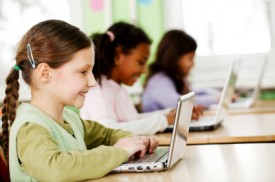
Blended learning, the combination of independent online learning with supervised brick and mortar programs, is on the rise. While there were 2.94 million students participating in a hybrid learning program in 2010, it is expected that the number will be 10.07 million by 2015.
This growth pattern surpasses homeschooling, virtual schools and online charter schools. Schools employing these methods believe that students are more engaged with a 24/7 access model and have seen improvement in both district achievement and graduation rates. It does require a culture shift that includes a strong emphasis on trust, but there are many benefits.
Through a blended learning program, educators can move beyond the “one teacher, one textbook model” of education in a host of ways, including:
- Allowing students to move at their own pace and excel
- Providing “just-in-time” intervention
- Grouping students more effectively
- Providing real world experiences
- Helping students construct meaning rather than just memorizing (and forgetting) facts
- Creating learning opportunities across grade levels, subjects, departments and between teachers and students
- Teaching problem-solving in multidisciplinary units
- Encouraging 21 stcentury collaborationthrough videoconferencing with authors, speakers and other students from around the world
- Increasing productivity – both for themselves and students
- And more
The trend toward blended learning within a district often begins in a specific school or grade level. For example, some districts start using blended learning strategies with their alternative education program, as the students are monitored by teachers at the alternative school but are supported by their general education teacher’s instruction, which can be delivered virtually. Others have found it makes sense to prepare students taking AP classes by providing virtual summer reading groups that include discussions and self-assessments in pre-class learning.
As blended learning takes hold with the starting group, the enthusiasm often quickly spreads when teachers see the opportunities for stronger student engagementand enhanced learning. Some districts also have found it helpful to implement online professional development programs as another way to help teachers gain acceptance and make the transition to blended learning.
Teachers can build powerful learning systems over time by adding online components to their classes. Starting gradually allows teachers to learn at their own pace and gives them a better understanding of what is needed on the teacher’s side to make blended and online learning more successful for students. A simple way to begin is with a blogging program, posting stimulating questions to foster student discussion, then guiding students in ways to respond appropriately to their peers in writing. Once the initial tools and processes are mastered by teachers and students, teachers can expand the initiative by asking students to turn assignments in electronically, encouraging students to participate in discussion boards or providing online quizzes that are self-graded.
Incorporating a virtual option into their classroom model enables teachers to more easily and effectively communicate with parents, collaborate district-wide via online communities and distribute curriculum materials. When curriculum maps are loaded into the district learning platform, students, parents and teachers can see where they are in the curriculum, and where they should be, at any given point in time.
The addition of virtual learning options can also solve pacing disparities that are more difficult to address in standard classrooms, such as providing more rigorous programs and college courses (engineering and biomedical classes, etc.) for advanced students. Similarly, students in need of credit recovery can be grouped in virtual learning programs that help them catch up and move forward, rather than re-teaching in the traditional environment.
Transitioning to a blended learning model is not about spending more, but about reallocating resources, changing mindsets and creating a paradigm shift within an existing culture. Most importantly, though, it’s about doing what is right for kids. The world they live in is fast, flexible, and online, and their schools should be, too.
References
Blended Learning Strategies for K-12 Leaders
Hybrid Learning Pushes Personalization Forward
Related Reading:
The Trend to Blend: The Debate Over Online and Blended Learning
Individualizing Instruction Through Understanding Different Types of Learners

